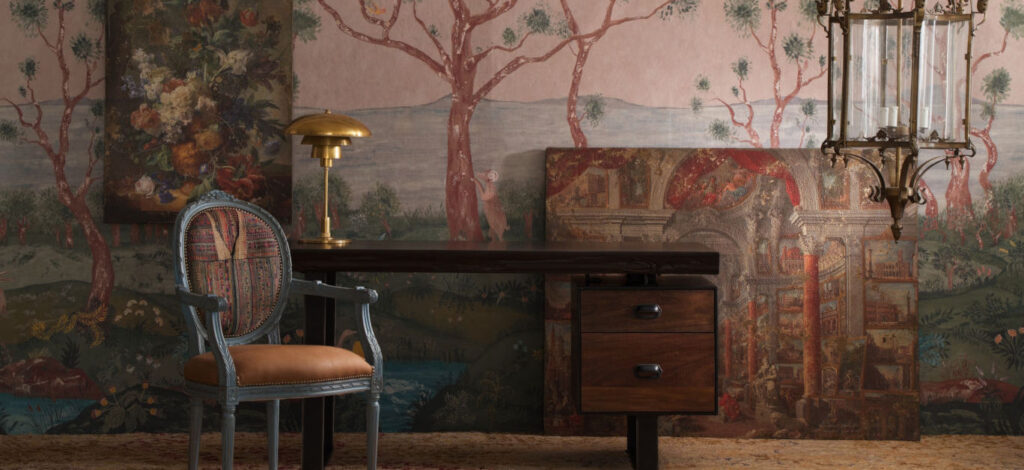Words from Martin Waller, founder of the global design house Andrew Martin.
As the saying goes, traveling expands the mind. As you cruise down the Amazon River in a carved canoe, the canoe stretches and warps. Escape to Cambodia to find temples beyond Angkor Wat will ignite something within. Traveling becomes an addiction, an obsession that leaves you groaning with hunger even when you feed it.
The gift of travel has given us the opportunity to see and absorb cultures and places that are completely different from our own. We can now see for ourselves wonders that were previously thought to be the stories of tourists. Exploration gives us access to a treasure chest of the world's grand cultural traditions, and people often want to share these experiences through the medium of their own sanctuaries upon their return. After all, your home is the backdrop to your life, so its interior design should reflect what you love, including your personality and the places you've visited.
 The gift of travel has given us the opportunity to see and absorb cultures and places that are completely different from our own.
The gift of travel has given us the opportunity to see and absorb cultures and places that are completely different from our own.
A design scheme starts with one detail. This could be a particular color, an interesting texture, or a theme with a story from a favorite craft or quirky personal item from a recent trip. From there, the room builds up layers, allowing you to play with materials such as steel and stone, leather and hessian, old and new. It's about telling a story and creating surprises with beautiful pieces lined up along the way.
Since the advent of the travel generation, access to and interest in foreign textiles has rapidly increased. People are choosing fabrics that bring energy and emotion and look like one-of-a-kind, one-of-a-kind pieces. Asian kilim stripes, West African mud cloth motifs and Mexican embroidery are now common in British interiors.
 Exploration gives us access to a treasure chest of the world's grand cultural traditions, and people often want to share these experiences through the medium of their own sanctuaries upon their return.
Exploration gives us access to a treasure chest of the world's grand cultural traditions, and people often want to share these experiences through the medium of their own sanctuaries upon their return.
Another example is Berber rugs. The rug style originates from the nomadic Berber tribes of the Atlas Mountains of North Africa. Rug weaving has a rich history and tradition, so it's no wonder its geometric designs and trellis motifs have found their way into modern interiors. Berber rugs are distinguished by their craftsmanship, featuring an asymmetrical trellis design made from natural wool, soft cream and charcoal dyes. Berber rugs embody the fusion of centuries of weaving wisdom, classic color schemes, and whimsical yet contemporary patterns, making them essential rugs for modern interiors.
Beyond the Berber tribes and their timeless creations, it was in Thailand that I first witnessed the miracle of silk production and the painstaking work of ikat weaving. This method requires a full day of weaving to produce just one meter of silk. But it wasn't just the product that attracted me. It was the gentle patience of the weavers, the skill of the dyers, and the techniques that have been passed down from ancient times.
 Rather than being limited to one style, people are now influenced by a global assortment of designs.
Rather than being limited to one style, people are now influenced by a global assortment of designs.
Unique trinkets and art from far-flung destinations also form some of our most prized possessions. The act of collecting items while exploring this world is meditative. Such items reflect eras and dates, and are not just something to admire in beauty, they combine to build a repository of memories. The collection of ancient Egyptian funerary masks is one of my favorite finds. They serve as a beautiful reminder of our mortality. I also keep a collection of vintage toys from my childhood in the library.
Now, instead of being limited to one style, people are influenced by a global assortment of designs. From the perfect symmetry of American facades, to the magic of African tribal art, to the tranquility of Scandinavia, to the heritage of French sophistication, to the individualism of British decor. For this reason, I have named this decade of his life the Kaleidoscope Era. It's a menagerie of objects full of nostalgia and sentiment, each with a truly moving power. Just like with clothing jewelry and cufflinks, the more unexpected, the better.
All image credits: Andrew Martin



